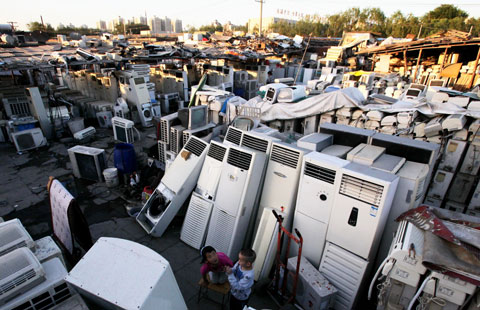Tapping into safer water access
By Wu Wencong and Zheng Jinran (China Daily) Updated: 2012-05-24 03:53New standards for drinking water will come into force in China on July 1, with the number of quality indicators rising to 106 from 35. While that's almost on a par with the standards used in the European Union, some experts have raised concerns about the feasibility of the new system.
![A staff member from Beijing Waterworks Group tests a water sample before it flows to the pipeline. New qaulity standards for drinking water will come into effect on July 1. [Photo/provided to China Daily] Tapping into safer water access](../../attachement/jpg/site1/20120524/001aa018f83f1127a56101.jpg) |
|
A staff member from Beijing Waterworks Group tests a water sample before it flows to the pipeline. New qaulity standards for drinking water will come into effect on July 1. [Photo/provided to China Daily] |
"There are about 3,000 water companies in China. Judging by their production technologies and their quality-testing facilities, most still have a long way to go before they can meet the new standards," said Li Fuxing, director of the Beijing Institute of Public Health and Drinking Water.
Meanwhile, Fu Tao, director of Tsinghua University's Water Policy Research Center, said that the number of cities with the facilities to test all 106 indicators covers a very small portion of the area served by the industry.
Traditionally, the treatment process consists of four steps: flocculation, precipitation, filtration and chlorination. The first three remove particle pollutants and reduce the water’s turbidity, making it clearer to the eye, while the addition of chlorine kills micro-organisms.
Chlorination is seen as one of the major innovations of the 20th century, but in 1977 scientists in the United States discovered that organic compounds left in the water after the first three steps in the treatment process may react with chlorine to generate potentially carcinogenic byproducts.
Under the regulations, first released in 2006, all treatment plants are obliged to meet the new criteria by July 1 this year. Some cities, such as Beijing, quickly achieved that goal, but despite the five-year hiatus, many companies have yet to upgrade their equipment or production techniques. "By the end of 2009, 98 percent of China’s water plants were still employing production processes that have been in use for decades," Lan Weiguang, adjunct associate professor from the chemistry department of the National University of Singapore, wrote in his micro blog.
Meanwhile, the number of indicators to test for organic compounds in drinking water will rise to 53 from just five. "That means the government has realized the importance of controlling organic pollutants," said Lan. "But most water plants fail to meet the target because of outdated production processes."
Some experts have asked why it's taken so long for the new regulations to come into force. "Other countries may use fewer indicators than us, but they are strictly implemented as soon they’re released. We have waited five years for these standards to be enforced," said Li. "Also, in many countries, the standards are revised annually, based on various data," he added, noting that, before 2006, the last revision in China was back in 1985.
The 2006 standard unified the water quality standards in the country’s rural and urban areas for the first time. But even as plants in the city struggle to meet the new criteria, those in rural areas face an even tougher challenge because their quality standards have always lagged behind.
Take quality monitoring in the rural areas of the southwestern province of Sichuan as an example. Work didn’t begin until 2004 and official statistics show that only 20 indicators were being measured by 2011, nowhere near the 1985 standard of 35, to say nothing of the 106 stipulated by the 2006 reforms.
Despite this, Sichuan is seen as something of a role model in the improvement of water quality, having undertaken a large number of projects to provide safe drinking water to its rural population, which is geographically dispersed over vast distances with many people living in inaccessible mountainous regions. Meanwhile, the situation in provinces such as Yunnan and Guizhou is much worse.
- Seven villagers murdered in N China
- China steps up tobacco control efforts
- Five jailed for separatism in Xinjiang
- Letter asks for leniency in poisoning case
- Antibiotics in surface water pose 'indirect health risk'
- Tianjin airport opens up transit link to Beijing
- High levels of antibiotics in China's major rivers
- China to dig tunnel for Asian rail system
- Bering strait line to US possible, experts say
- China: Stop oil rig harassment







